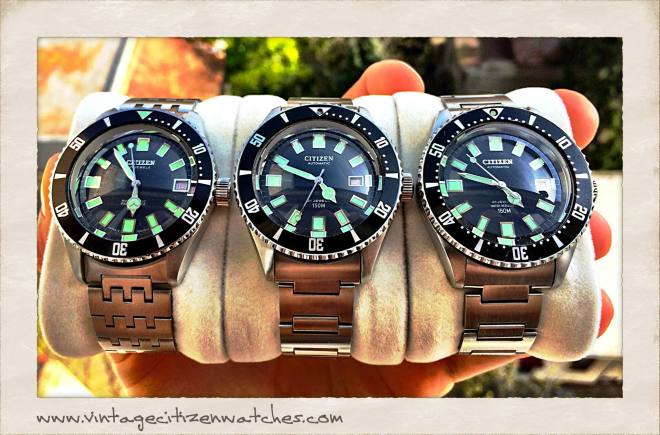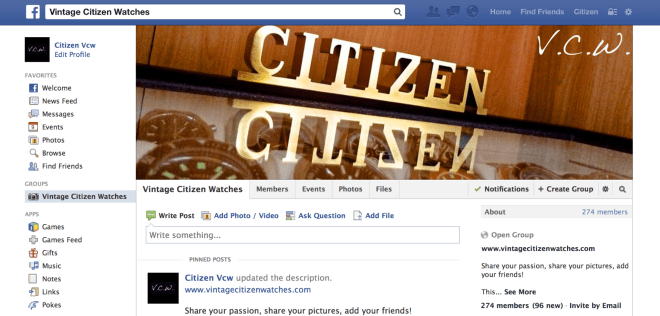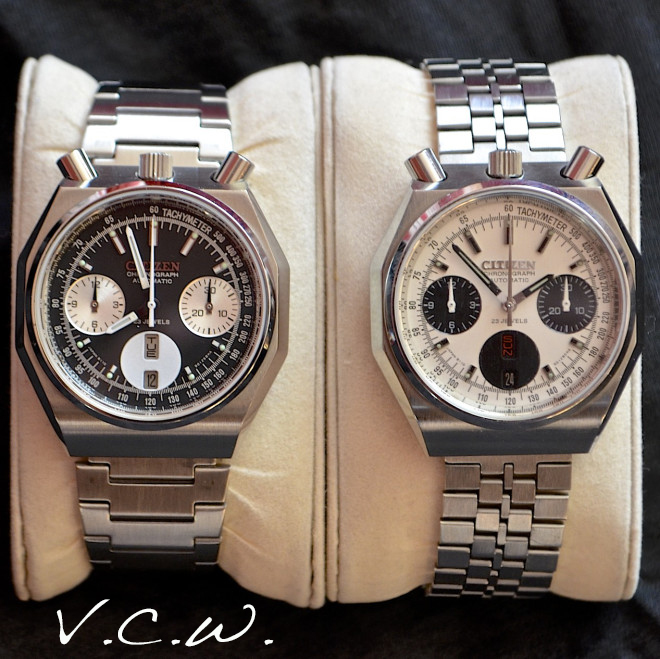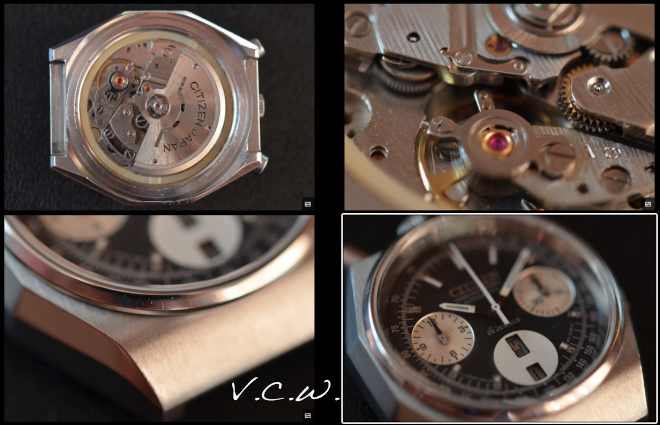The Mayor of Tokyo, Mr Shimpei Goto, named the watch “CITIZEN” with the hope that the watch, a luxury item of those times, would become widely available to ordinary citizens and be sold throughout the world. He got this right.

The official table (from official Citizen website):
| Year |
Month |
Event |
| 1918 |
3 |
Shokosha Watch Research Institute established, the forerunner of Citizen Watch Co., Ltd. |
| 1924 |
12 |
First pocket watch completed. |
| 1930 |
5 |
Citizen Watch Co., Ltd. established. Yosaburo Nakajima appointed president. |
| 1931 |
6 |
First wrist watch completed. |
| 1936 |
5 |
Tanashi Factory constructed. |
| 1941 |
7 |
Production of machine tools begins. |
| 1945 |
10 |
Shinji Nakajima appointed president. |
| 1946 |
3 |
Eiichi Yamada appointed president. |
| 1949 |
6 |
Citizen Trading Co., Ltd. established. |
| 1952 |
3 |
First Japanese-made watch with a calendar introduced. |
| 1953 |
3 |
Rhythm Watch Co., Ltd. becomes an affiliate. |
| 1955 |
12 |
Export of wrist watches begun. |
| 1960 |
3 |
Import-export agreement concluded with the U.S. Bulova Watch Co.
Technical assistance agreement with India. |
| 1964 |
8 |
Technology research laboratory established. |
|
12 |
Citizen Business Machines established. |
| 1965 |
3 |
Production of business machines begun. (Adding machines, camera shutters) |
|
10 |
Office opened in former West Germany, start of full-fledged exports to Europe. |
| 1966 |
3 |
First Japanese-made electronic watch “X-8” introduced. |
| 1970 |
3 |
CNC automated lathe “Cincom” developed. |
| 1971 |
6 |
Precision Machinery Division established. |
| 1976 |
3 |
Production of quartz oscillators begun. |
| 1978 |
2 |
Head Office moved to Shinjuku Mitsui Bldg. in Tokyo. |
| 1980 |
6 |
Industry’s first microcomputer controlled line impact printer introduced. |
| 1981 |
6 |
Rokuya Yamazaki appointed president. |
|
10 |
Systems and Peripherals Division established. |
| 1982 |
9 |
Special Sales Division established, full-fledged sales of watch components started. |
| 1983 |
3 |
Chip LED lamp CL Series developed. |
|
5 |
IC sensor electronic thermometer introduced. |
| 1987 |
6 |
Michio Nakajima appointed president. |
| 1990 |
1 |
Citizen of the Year annual award established. |
| 1992 |
2 |
Acquired German machine tool company, Boley GmbH. |
| 1993 |
5 |
World’s first multizone “Radio-Controlled Watch” introduced. |
| 1996 |
4 |
Solar-powered Eco-Drive received the Eco Mark the first for a watch. |
| 1997 |
6 |
Hiroshi Haruta appointed president. |
| 2001 |
3 |
Head Office moved to Nishi-Tokyo. |
| 2002 |
3 |
Sales of white LED as a backlight for color LCDs started. |
|
6 |
Makoto Umehara appointed president. |
| 2003 |
6 |
World’s first full metal case radio-controlled watch with built-in antenna introduced. |
| 2004 |
1 |
Implemented Citizen Code of Conduct. |
|
10 |
Merged with Citizen Trading Co., Ltd. |
| 2005 |
4 |
Citizen Systems Japan Co., Ltd. established. |
|
10 |
Five consolidated companies (Citizen Electronics, Miyota, Cimeo Precision, Sayama Precision Industries, Kawaguchiko Precision) become wholly owned subsidiaries. Names of Citizen Group companies changed. |
| 2007 |
4 |
Company name changed to Citizen Holdings Co., Ltd. |
| 2008 |
4 |
Mitsuyuki Kanamori appointed president. |
|
7 |
Citizen Miyota Co., Ltd. and Citizen Finetech Co., Ltd. merge.
Citizen Finetech Miyota Co.,Ltd. established. |
|
10 |
Miyano Machinery Inc. becomes a consolidated subsidiary. |
| 2011 |
4 |
Citizen Machinery Co.,Ltd. and Miyano machinery Inc. merge.
Citizen Machinery Miyano Co., Ltd. estabilished. |
| 2012 |
4 |
Toshio Tokura appointed president. |
Source: http://www.citizen.co.jp

And a few additions from here: http://forums.watchuseek.com/member.php?u=15164
The forerunner to what we now know as The Citizen Watch Co. Ltd., began life in 1918 under the name Shokosha Watch Research Institute. Buoyed on by an ambitious Mayor who demanded that the Shokosha-Watch Institute should have a bearing on all citizens, in so far as “people appreciated and benefited from the institute’s results”. Prophetic words indeed – from this statement, the seeds were sown that would help produce the world’s largest watch manufacturer.
1920’s
In 1924, the first pocket watch to bear the Citizen moniker was produced.
One of these first products produced by the company was purchased by Emperor Showa, Prince Regent at the time (Emperor Taisho era).
1930’s
In 1930, Yosaburo Nakajima laid the foundations of the Citizen watch empire.
In 1931, a 10½ ligne caliber is in production, followed in 1935 by an 8 ¾.
1936 saw the company expand beyond the boundaries of Japan, exporting watches to many parts of Southeast Asia.
1940’s
In 1940 a 5 1/4 ligne caliber was introduced. During World War Two, Citizen moved their production facilities to a small town 200km from their former location in Tokyo. The company manufactured many components, amongst which were chronometers and igniters for military use.
1949 saw the creation of The Citizen Trading Company. This entity controlled the distribution and marketing of Citizen watches throughout the world.
1950’s
In the early part of 1950’s, Citizen completed Cal. 960(M), its first 6 beat caliber with 17 jewels, and Cal. C, Japan’s first men’s wrist watch fitted with date display known as “Citizen Calendar”. In 1953, Citizen acquired a clock manufacturer, The Rhythm Clock Co. (currently named “The Rhythm Watch Co., Ltd”), as an affiliated company.
1956 was a momentous year for the brand. The company produced the first shock-proof Japanese watch, known as the Parashock.
In 1958, the company produced its first automatic-winding wrist watch “Auto” fitted with Cal.3KA, and Japan’s first manual winding alarm caliber with 19 jewels, Cal.980(A). Also the introduction of “Citizen Deluxe” fitted with Cal.920, Citizen’s first caliber with central seconds, proves a hit with the watch buying public, with sales of over 100 million pieces.
In 1959, the company produced the first Japanese water-resistant wrist watch, the “Citizen Parawater”, Cal. 920(2B).
1960’s
At the start of the 1960’s, the Parawater completed two trans-Pacific tests, as well as one in the Sea of Japan – all passed with flying colors.
1960, Citizen signed an export/import agreement with USA’s Bulova Watch Company.
1962 saw the company introduce an officially certified chronometer and the world’s thinnest men’s wrist watch with center seconds, the “Diamond Flake”, Cal.0700.
The year 1963 heralded the introduction of the Quartz-transistor clock.
In 1964, pursuing a diversification strategy, Citizen founded the Citizen Office Machine Co., Ltd. (today’s Japan CBM Corporation).
In 1965, Citizen started producing office equipment and precision manufacture components.
In 1966, Citizen introduces Japan’s first electronically regulated balance wrist watch known as “X-8” or “Cosmotron”.
1967 saw the company put the world’s first quartz transistor clock into the market.
1970’s
The 70’s were another prolific decade for Citizen, and also the beginning of the company’s move towards the quartz technology that dominates its current output. However, Citizen did not completely move away from mechanical movements during this decade.
1970 saw the introduction of the world’s first Titanium cased watch “X-8 Chronometer”, followed by a tuning fork caliber a year later.
In 1972, Citizen evolved the 60’s “Sports Master”. They developed an brand new automatic chronograph, named the “Easter Rabbit” – commonly referred to by English speaking collectors as the “Bullhead” (or the “Panda” in Japan). The “Easter Rabbit” showcased calibre 8110, which included a zero-position reset mechanism fitted with a shock absorber.
In 1973, the company launches its first quartz wrist watch, fitted with Cal. 8810.
During 1974, Citizen signals its intent to seriously pursue quartz technology by introducing a quartz movement, Caliber 8600EX, fitted with Japan’s first stepping motor mechanism*.
By 1975, the launch of the now legendary Crystron Mega Quartz left the watch world with little, if any, doubt about where Citizen were heading as an brand. Fitted with caliber 8650, generating a frequency of 4,194,304Hz, it is still to this day one of the world’s most accurate (and priced at approx. Y15,000,000 one of the most expensive) wrist watches ever offered for public sale.
In 1975, The Citizen Watch Co. of America Inc. is established.
In 1974, solar powered technology is first introduced, not to mention the first Japanese LCD technology watch.
1978 saw the company introduce a 0.98mm thick quartz caliber, “Quartz 790”.
By 1978, the company moves to the Shinjuku Mitsui building in Tokyo, followed in November of that year with the release of the Citizen Quartz Digi-Ana, fitted with caliber 8900 – it featured a combination of digital LCD and analogous time indication.
1980’s
By 1980, Japan had become the world’s largest producer of watches and watch movements. November of this year brought the release of ladies wrist watches fitted with the world’s smallest volume movement, “The Exceed Gold”.
Towards the end of 1981, Citizen released their 1300m Professional Diver’s watch. At the time, it was the world’s most water resistant watch available for public use.
By 1982 the diversification that started in the 1960’s, saw Citizen produce the world’s largest Neon-Light advertisement installed in Hong Kong.
1985 saw the release of the world’s first watch fitted with a depth gauge, the “Sport Depth Meter”.
By 1986, Citizen becomes the world’s largest single manufacturer of watch movements.
In 1987, the company introduced the “Voice Master” or “Voice Memo” (in Japan)”, VX-2, the first wristwatch with voice recognition.
1990’s
The 1990’s were almost as significant and prolific in terms of world’s firsts than the 70’s were for the company. In the early 1990’s Citizen launched the Analog-Aqualand, the first quartz watch with an analog depth gauge.
In 1992 Citizen became the official timekeeper of the America’s Cup yacht race.
In 1993, Citizen introduces radio-controlled watches to the market place.
1995 saw two significant additions to the world of Horology: “The Citizen” was released in May, backed with a ten year factory warranty and +/- 5 second a year accuracy; and November saw the introduction of Eco-Drive power generating technology, which quickly became Citizen’s number one seller.
1996 was another busy year. Citizen’s Eco- Drive technology was awarded the first “Eco-Mark”, an officially certified Japanese award for environmental protection. In July Citizen released the world’s thinnest solar cell equipped movement, only 3.14mm thick.
In 1997, Citizen launches the “Exceed Eco-Drive” to the Japanese market, featuring accuracy of +/- 10 seconds per year, followed closely by “Eco-Drive Signature Technology”, which corrects time differences when traveling between time zones.
1998 saw the introduction of the “Promaster Eco-Drive Aqualand” or “Promaster Aqualand Eco-Drive Analog Depthmeter” (in Japan) , the world’s first solar powered diver’s watch with an electronic depth gauge. In October, Citizen unveil the world’s smallest quartz movement, fitted to the Exceed Lady’s Eco-Drive.
By the end of the millennium, Citizen introduced “Promaster Eco-Drive Super Tough”, which can survive/withstand/resist the shock of an impact hammer 5 times more than non para-shock watches.
2000’s
Thus far, during the decade of 2000, Citizen has:
– Relocated its headquarters to Nishi-Tokyo City;
– Founded the Lead-Free Committee;
– Founded the Eco-friendly product subcommittee and green purchasing subcommittee;
– Developed the world’ slimmest radio-controlled watch;
– Introduced automatic time keeping for marathon/ekiden races through the use of IC chips;
– Introduced the Campanola range of High End Quartz watches.
– Merged [with] Citizen Shoji;
– Acquired Miyota Co. Limited as a going concern, which included several small component manufacturing subsidiaries; and
– On January 10th 2008 Citizen acquired USA’s Bulova Watch Company, including all its affiliated brands (Bulova, Caravelle, Wittnauer and Accutron) for US$247 million, making the combined company the world’s largest watchmaker.
*EDIT – Switzerland’s Girard-Perregaux hold the record for the worlds first stepper motor equipped quartz wristwatch.
source: http://forums.watchuseek.com/f9/brief-history-citizen-watch-company-175421.html
REFERENCES:
Citizen Watch Co.
Citizen Watch Co. of America Inc.
History of CSR – Citizen Watch Co. Ltd
Citizen Watch Co. Ltd – Wikipedia
Watches for the World – Uhren Juwelen Schmuck – Author; Gisbert L. Brunner
www.citizen.com.hk/
www.citizenwatch.com
MUST READ and THIS
I would like to thank to all involved in putting together this information and I hope that the amount of known data that will be available will grow constantly.
Read more about the first Citizen here: https://vintagecitizenwatches.com/2014/09/27/citizen-shokosha-pocket-watch/
















